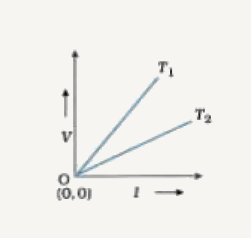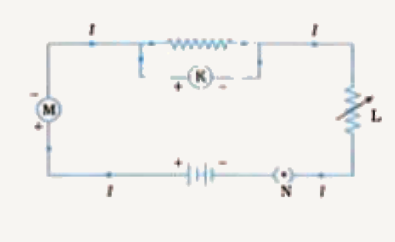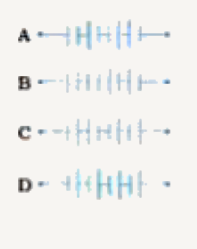Complete Solutions to OBJECTIVE QUESTIONS AND ANSWERS (Answer the following questions as directed (Miscellaneous):) of chapter ELECTRICITY of Class 10 book with complete answers and questions
| Class 10 | PHYSICS |
| Chapter | ELECTRICITY |
| KUMAR PRAKASHAN | OBJECTIVE QUESTIONS AND ANSWERS (Answer the following questions as directed (Miscellaneous):) |
| Number Of Questions | 53 |
| Academic Year | 2023-24 |
The voltage - current (V-1) graphs for a metallic conductor at two different temperatures `T_1 and T_2` are shown below:

At which temperature is the resistance higher?01:19View SolutionA wire of given length is doubled on itself and this process is repeated once again. By what factor does the resistance of the wire change?
03:04View SolutionThrough which of the following two wires, does the electric current flow more easily?
(a) A thick wire (b) a thin wire of the same material and of the same length when connected to the same source. State the reason.02:35View Solution400 J of heat is produced in 4 s in a 4.0ohm resistor. Find the potential difference across the resistor.
01:31View SolutionWhat is the commercial unit of electrical energy?
01:46View SolutionOn what principle is an electric bulb based?
01:15View SolutionIn a circuit, two resistors of resistances `5 Omega and 10 Omega` are connected in series. Compare the current passing through the two resistors.
01:49View SolutionWrite the reletion between resistance R of the filament of a bulb, its power and a constant voltage V applied across it.
01:29View SolutionWhich of the following bulbs has more resistance?
(a) A 220V, 100W bulb (b) a 220 V, 60 W bulb.02:19View SolutionFind the minimum resistance that can be made using five resistors, each of 5 `Omega`.
01:46View SolutionHow does the resistance (R) of a wire depend upon its radius (r)?
01:56View SolutionAn ammeter has a range (0 - 3A) and there are 30 divisions on its scale. Calculate the least count of the ammeter.
01:47View SolutionIn a voltmeter there are 20 divisions between 0 mark and 0.5 V mark. Calculate the least count of the voltmeter.
01:46View SolutionTo verify the Ohm.s law a circuit diagram was drawn by a student as shown below:

What do K, L, M, N stand for?01:33View SolutionFour students connect 4 cells of 1.5 V each to get a battery of voltage 6 V. State the incorrect connection / connections. Justify your answer.
 01:58View Solution
01:58View SolutionWhich of the following statements is correct?
(a) one volt is one joule per ampere.
(b) one volt is one joule per coulomb.01:35View SolutionKeeping the resistance constant, the potential difference applied across the ends of a component is halved. How does the current change?
02:09View SolutionKeeping the potential difference constant, the resistance of a circuit is halved. How does the current change?
02:09View SolutionA potential difference of 10 V is needed to make a current of 0.02 A flow through a wire. What potential difference is needed to make a current of 250 mA to flow through the same wire?
02:44View SolutionA current of 200 mA flows through a 4 kOhm resistor. What is the potential difference across the resistor?
01:43View SolutionThe electrical resistivities of four materials A, B, C and D are given below:
` A : 110 xx 10^(-8) Omega m`
`B : 1.0 xx 10^10 Omega m`
`C : 10.0 xx 10^(-8) Omegam`
`D : 2.3 xx 10^3 Omega m`
Which material is a (a) good conductor (b) resistor (c) insulator (d) semi-conductor?02:26View SolutionThe equivalent resistance of a series combination of two resistors is '9 Omega' and the equivalent resistance of a parallel combination of the same two resistors is `2 Omega`. Find the resistances of the resistors.
04:05View SolutionAn electric lamp is labelled 12 V, 36 W. This indicate that it should be used with a 12 V supply. What other information does the label provide?
02:06View SolutionName two devices whose working is based on the heating effect of electric current.
01:34View SolutionName the gases which are filled into the filament-type electric light bulbs.
01:09View SolutionWhy are the filament-type electric light bulbs not power efficient?
01:47View SolutionUnder what conditions is the Ohm.s law applicable?
01:22View SolutionWhy is Nichrome used as a heating element?
02:04View SolutionWhy are Constantan and Manganin used for making standard resistors?
01:45View SolutionWhy is lead-tin alloy used for making a fuse?
01:50View SolutionWhat is the difference between a resistor ~ and resistance?
01:57View SolutionWhat do you mean by the term load in an electric circuit?
01:16View SolutionHow does the current divide itself in a parallel combination of resistors?
02:22View SolutionHow does the potential difference divide itself in a series combination of resistors?
02:14View SolutionHow is heat produced in a conductor by an electric current?
01:47View SolutionIf a number of bulbs of different wattages are joined in parallel With a voltage source, which bulb will glow With maximum brightness?
02:48View SolutionWhich bulb will glow With maximum brightness in case bulbs of different wattages are joined in series With a voltage source?
02:45View SolutionWhat can you say about the resistance of an ammeter?
02:26View SolutionWhat can you say about the resistance of a voltmeter?
01:57View SolutionHow does the resistance of a metallic Wire depend on its temperature?
01:48View SolutionTwo wires have the same length, same radius but one of them is made of copper and the other is made of iron. Which Will have more resistance?
02:05View SolutionName a substance whose resistance decreases with temperature.
01:19View SolutionName a substance whose resistance almost remains unchanged With a change in temperature.
01:34View SolutionDistinguish between the kilowatt and the kilowatt hour.
01:28View SolutionName two characteristics of a heater coil.
01:54View SolutionThe power-voltage rating of an electric appliance is 100 W- 250 V What does it signify?
01:33View SolutionWhy is much less heat generated in long electric cables than in the filament of an electric bulb?
01:23View SolutionHow much energy is consumed by 2 kW AC when used for 2 hour?
01:34View SolutionA wire of resistivity p is pulled to double its length. What will be its new resistivity?
01:53View SolutionHow does the resistance of an ohmic conductor depend on the applied voltage?
01:46View SolutionWhat causes the potential difference between the two terminals of a cell?
02:52View SolutionName and define the smallest commercial unit of electricity.
01:32View SolutionIf, the current I, through a resistor is increased by 100.% (assume that the temperature of the resistor remains unchanged), find the percentage increase in power dissipated.
02:51View Solution
OBJECTIVE QUESTIONS AND ANSWERS (Answer the following questions as directed (Miscellaneous):) questions and complete solutions for chapter ELECTRICITY of KUMAR PRAKASHAN of Class 10
All Exercises from KUMAR PRAKASHAN Class 10 PHYSICS ELECTRICITY
- ADDITIONAL QUESTION AND ANSWERS (additonal information :)
- ADDITIONAL QUESTION AND ANSWERS (Give scientific reasons for the following statements :)
- ADDITIONAL QUESTION AND ANSWERS (Solve the following examples:)
- ADDITIONAL QUESTION AND ANSWERS (State at least three points of difference between the following terms / quantities: )
- OBJECTIVE QUESTIONS AND ANSWERS (Answer the following questions as directed (Miscellaneous):)
- OBJECTIVE QUESTIONS AND ANSWERS (Answer the following questions in one word/ sentence:)
- OBJECTIVE QUESTIONS AND ANSWERS (Choose the correct option from those given below each question: )
- OBJECTIVE QUESTIONS AND ANSWERS (Fill in the blanks: )
- OBJECTIVE QUESTIONS AND ANSWERS (Match the following:)
- OBJECTIVE QUESTIONS AND ANSWERS (State whether the following statements are true or false: )
- PRACTICAL SKILL BASED QUESTION WITH ANSWERS
- QUESTIONS AND ANSWERS
- QUESTIONS AND ANSWERS (INTEXT QUESTIONS)
- QUESTIONS AND ANSWERS (MORE TO KNOW)
- QUESTIONS AND ANSWERS (TEXTBOOK ILLUSTRATIONS)
- TEXTUAL EXERCISE
- VALUE BASED QUESTIN WITH ANSWERS
